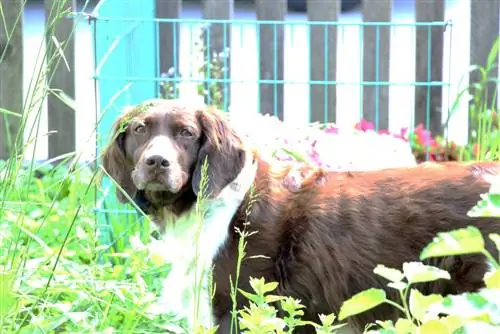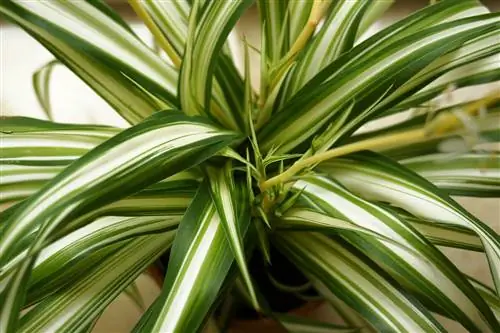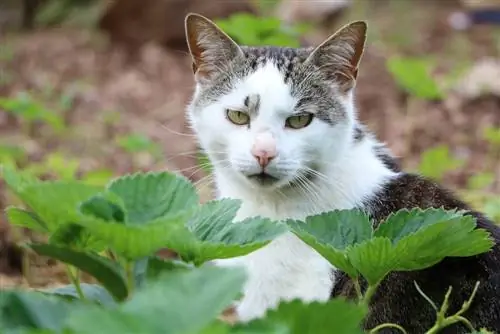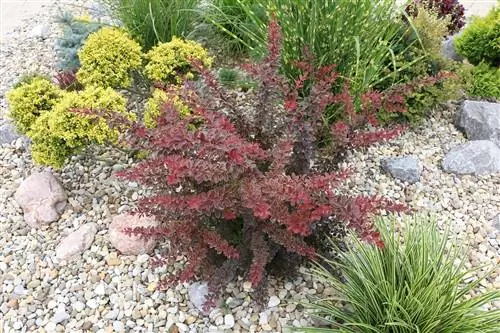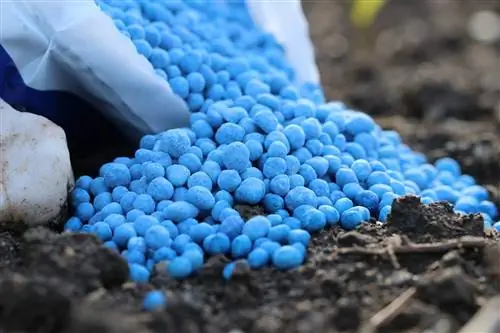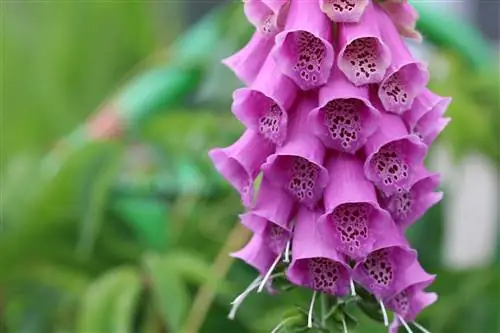- Author admin [email protected].
- Public 2023-12-17 03:39.
- Last modified 2025-06-01 06:48.
Dogs don't have much to do with plants, and they never have; the instincts that warn against poisonous plants didn't have to be particularly well developed by the wolf. Today's domestic dog has long forgotten what was there; It wouldn't have helped him with imported, poisonous exotics anyway. There are a lot of imported, poisonous exotic plants, so our domestic dogs are constantly dealing with poisonous plants around them. Owners should definitely know the most poisonous ones (and remove them from the immediate domestic environment). The most dangerous poisonous plants for dogs are presented below:
Profile: Dangerous dog world
- Today's dog probably doesn't even recognize the most dangerous native poisonous plants anymore
- As a carnivore, he is already inept at recognizing poisonous plants
- The few existing instincts have not been improved by a few thousand years of dog breeding
- Epigenetic influence has made city dogs even more unable to classify poisonous plants
- Today's dog also has to deal with quantities of ornamental plants imported from far away
- A large part of which is poisonous to dogs
- That's why dogs who always have to put everything in their mouths live dangerously in today's world
- Even underemployed old dogs like to nibble, when in doubt about the “defenseless plant”
- To prevent nibbling from becoming a habit, domestic dogs should be kept well occupied (busy)
Extreme caution - the really dangerous poisonous plants
Dogs are not genetically “designed” to be herbivores; When a wolf really filled its stomach with (over-)ripe apples, it was more of a kind of dessert (+ probably followed by a “spontaneous emptying” that meant a thorough intestinal cleansing). The intended main food is the prey animal, and its stomach contents (which were first eaten) were the main plant material that ended up in the free-living progenitor wolf. Pre-digested and so the food components are broken down in a way that is compatible with wolves; when it comes to toxic substances, the hunted prey also acts as a “taster”.
The Canideae (dog) genus probably did not develop any really great instincts towards plant poisons. The Canis lupus familiaris (domestic dog) has forgotten 90% of this in around 40,000 years of living with humans; Some breeds of dog breeding, which have been practiced for thousands of years, are now so degenerated that their fellow dogs can barely sniff out their Chappi. Since the end of the 18th century. At the turn of the 20th century, our dogs are still being presented with more and more ornamental plants from foreign continents in “their homes” - it's actually no big surprise that poisonings are numerous and the list of poisonous plants dangerous to dogs is impressively long.
So that your attention can stay on the one feature “terribly poisonous, absolutely avoid with dogs”, all terrible poisonous plants are listed alphabetically. Regardless of whether these plants are statistically more likely to be found in the garden, in a container on the terrace, in a pot in the house - some plants can appear anywhere or migrate from indoors to outdoors with the season.
Poisonous plants A-L

- Bracken fern, Pteridium aquilinum, highly poisonous
- Adonis florets, Adonis sp., highly poisonous
- Azalea, highly poisonous, 1-2 leaves can be fatal
- Belladonna lily, Amaryllis belladonna, highly poisonous
- Mountain laurel, Kalmia angustifolia, highly poisonous
- Broom broom, Cytisus scoparius, highly poisonous
- Bitter almond, Prunus dulcis var. amara, highly poisonous
- Bittersweet, Solanum dulcamara, highly poisonous
- Boxwood, Buxus sempervivens, highly poisonous
- Buckwheat, Fagopyrum esculentum, young flower + seed coats are highly poisonous
- Christmas rose, Helleborus niger, highly poisonous
- Dieffenbachia, Dieffenbachia senguine, highly poisonous
- Yew, Taxus baccata, highly poisonous, 30 g needles/animal are deadly
- Monkshood, Aconitum sp, !most poisonous plant in Europe!
- Angel trumpet, Brugmansia sp., is one of our most poisonous plants (wild form: Datura)
- Foxglove, Digitalis sp., highly poisonous, death after 5 g of dry leaves
- Germer, Weisser, Veratrum album, highly poisonous
- Bell henbane, Scopolia carniolica, highly poisonous
- Gold lacquer, Erysimum cheiri, highly poisonous
- Laburnum anagyroides, highly poisonous
- Autumn crocus, Colchicum autumnale, highly toxic, severe diarrhea from 0.25 mg/kg body weight, death from 1 mg/kg body weight
- Sky blossom, Duranta erecta, highly poisonous
- Dog poison, Apocynum sp., highly poisonous, see oleander
- Dog parsley, Aethusa cynapium, highly poisonous
- Cocoa tree, Theobroma cacao, highly poisonous
- Cherry laurel, Prunus laurocerasus, highly poisonous, contains hydrogen cyanide, lethal amount 1-4 mg/kg body weight
- Croton, Codiaeum variegatum, highly poisonous
- Lavender heather, Pieris sp., highly poisonous, 1-2 leaves can be fatal
- Tree of life, Thuja sp., highly poisonous
- Flax, Linum usitatissmum, highly poisonous
- Laurel roses, Kalmia sp., highly poisonous, 1-2 leaves can be fatal
Poisonous plants M-S
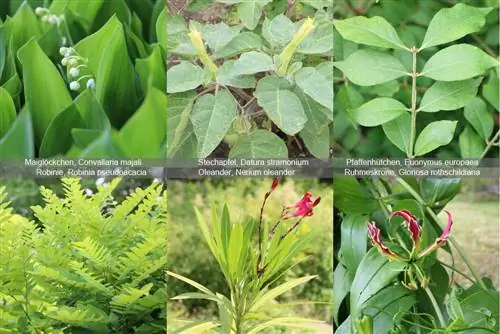
- Lily of the valley, Convallaria majalis, highly poisonous
- Poppy, dormouse, Papaver somniferum, highly poisonous
- Nightshade, Solanum sp., highly poisonous
- Daffodil, Narcissus pseudonarcissus, highly poisonous
- Hellebores, greens, Helleborus viridis, highly poisonous
- Oleander, Nerium oleander, highly poisonous, 0.005% of body weight in dried leaves can be fatal
- Pfaffenhütchen, Euonymus europaea, highly poisonous
- Magnificent lily, Gloriosa superba, highly poisonous
- Rhododendron, Rhododendron sp., highly poisonous, 1-2 leaves can be fatal
- Dark spur, Delphinium sp., highly poisonous
- Castor bean, Ricinus communis, highly poisonous, is one of our most poisonous plants, a few castor seeds are enough as a lethal dose
- Robinia, Robinia pseudoacacia, highly poisonous
- Crown of Glory, Gloriosa rothschildiana, highly poisonous
- Sade tree, Juniperus sabina, highly poisonous
- Shadow bell, Pieris sp., highly poisonous, 1-2 leaves can be fatal
- Schellenbaum, Thevetia peruviana, highly poisonous
- Hemlock, spotted, Conium maculatum, highly poisonous, is one of the most poisonous plants
- Celandine, Great, Chelidonium majus, highly poisonous, death after 60-120 g of leaf juice
- Daphne mezereum, highly poisonous, is one of our most poisonous plants, death after 12 g of bark
- Datura stramonium, highly poisonous, is one of our most poisonous plants
- Holly, Ilex aquifolium, highly poisonous
- Stink juniper, Juniperus sabina, highly poisonous
Poisonous Plants T-Z
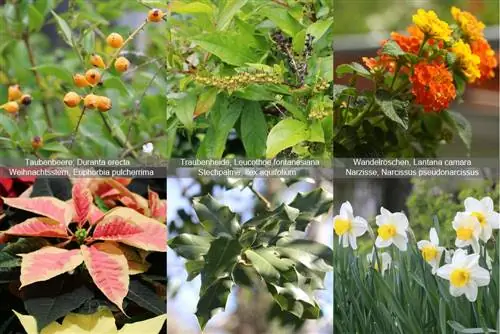
- Pigeonberry, Duranta erecta, highly poisonous
- Deadly nightshade, Atropa bella-donna, highly poisonous, is one of our most poisonous plants
- Rapidwort, Scopolia carniolica, highly poisonous
- Grape heather, Leucothoe fontanesiana, highly poisonous, 1-2 leaves can be fatal
- Tropical oleander, Thevetia peruviana, highly poisonous
- Lantana camara, highly poisonous
- Water hemlock, Cicuta virosa, highly poisonous, is one of our most poisonous plants
- Poinsettia, Euphorbia pulcherrima, highly poisonous, the existing non-toxic varieties cannot be distinguished from the toxic ones
- Grapevine, Vitis vinifera spp. sativa, highly poisonous in all parts of the plant
- Spurge, Euphorbia sp., highly poisonous
- Miracle tree, Ricinus communis, highly poisonous, is one of our most poisonous plants, a few castor seeds are enough as a lethal dose
- Wonder bush, Codiaeum variegatum, highly poisonous
- Worm fern, Dryopteris filix-mas, highly poisonous
- Desert rose, Adenium obesum, highly poisonous
- Bryonet, Bryonia sp., highly poisonous
- Ornamental pepper, Capsicum annuum, whole plant highly poisonous, fruits contain only a few alkaloids
Note
Preventative information to avoid accidents is best retained if it is obtained in advance (without pressure, in the case of “Dogs and Poisonous Plants” before the most at-risk and most sensitive young dog is in the house). Take a careful and thorough look at the poisonous plants that can be dangerous to your (future) dog, and refresh your knowledge occasionally later. Find the strongest poisonous plants in your area, ask your veterinarian how poisoning would be treated with them, write down the telephone number of the nearest poison control center on your smartphone and on a piece of paper on the refrigerator/in your wallet. List of poison control centers: www.bvl.bund.de/DE/01_Lebensmittel/03_Ververbraucher/09_ PräzisionenIntoxikationen/02_Giftnotrufzentralen/lm_LMVergiftung_giftnotrufzentren_node.html.
The home environment: full of dog dangers
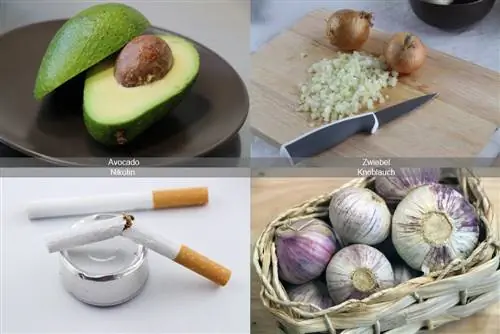
Among the garden and house plants, there are plenty of other plants that won't kill a dog who nibbles on leaves, but can cause all sorts of (temporary) problems in the dog's body, from diarrhea to muscle twitching, weakness and anemia.
Even dogs who normally eat grass to cleanse their intestines can have bad luck if the grass is attacked by fungi that produce toxins.
The probabilities here are in the range of individual percentages, with one of many different grasses in the lawn - the grass-fungi are only mentioned here because they want to bring something else into focus: today's plant world with all of it The wonders of modernity (exotic imports, monocultures promoting the development of fungi, artificial fertilizers) are as foreign to your dog's organism as a modern dog owner who relies on advertising is to the contents of his cleaning cupboard (with all the wonders of modern chemistry).
Foreign to the organism means: intolerable to toxic. As soon as a dog living in today's world shows symptoms that go beyond limping after the Kabolz while running around or vomiting after eating the holiday roast stolen from the buffet, or that appear to appear without cause at all, you should briefly think about the possibility of poisoning.
That was the dangerous world outside, but in the closest environment (pack cave / apartment / house) there are still a few dangers lurking for dogs that not every owner is sufficiently aware of.
Many dogs love to cook, in the sense that the floor is immediately and thoroughly cleaned of any food residue that falls off during cutting. Cleaning takes place through consumption, and some dog owners actually drop a few dog treats every time such a dog owner cooks “together” with a dog whose taste was not reduced to “pure beef tartare” or “Reinina Premium” in their youth. This dog should never be exposed to the following things: avocados (gastrointestinal symptoms + pancreatitis), raw yeast dough / sourdough (alcohol poisoning, for a 4 kg dog 250 g of dough is enough), garlic and onions (in larger quantities too cooked, cause, among other things, a special form of anemia).
Many dogs also enjoy snacking in front of the TV; the strictest ban applies here to macadamia nuts (poisonous, reason unknown, symptoms usually go away after 48 hours), raisins from trail mix (strongly poisonous for unknown reasons). Reason, kidney failure possible from 2.6 g per kg body weight); and a piece of chocolate is just as forbidden as the grapes from the fruit plate (dogs die from cocoa theobromine from 250 mg per kg body weight=62.5 g or a few pieces of 70% chocolate for the 5 kg small dog, grapes s.above raisins, kidney failure possible from 10 g per kg body weight).
If you are always up to date with the latest trends on the food market (food substitute products market), double caution is advisable: For example, the sweetener xylitol, which is already contained in many candies, chewing gum, etc., is toxic to dogs and dogs has recently also been offered as a sugar substitute for baking; From 50 mg xylitol/kg body weight, decontamination is recommended; this is quickly achieved if a dog gets baked goods made with xylitol between its jaws.
Tip:
If you want to avoid accidents, you need imagination, especially in terms of what can lead to an accident happening. For the “poison and poisoning” area, this means that it is best to get into the habit of checking all products in packages with ingredient lists for toxic ingredients. If your dog steals a few horn shavings from the farrier, he can enjoy these “dog chips”; If he steals them from your package of horn shavings for the garden, he could experience his poisonous miracle. If you haven't read that castor bean meal was mixed into the horn shavings (with ricin, see above, castor bean, miracle tree).

